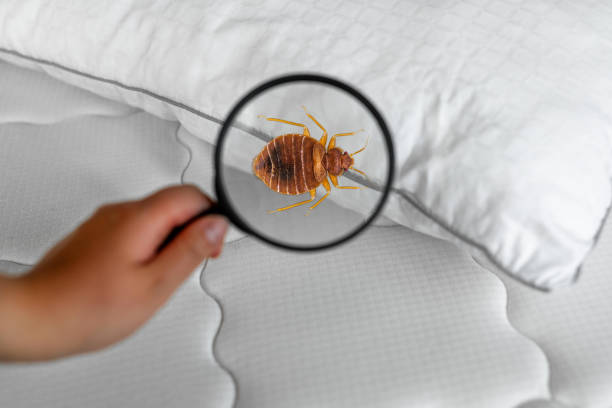- Early detection is crucial – Regularly inspecting your mattress helps catch bed bugs before they spread and become a full-blown infestation.
- Know where to look – Bed bugs hide in mattress seams, edges, corners, box springs, and nearby furniture; tight spaces are their favorite spots.
- Use the right tools – A flashlight, magnifying glass, gloves, and a small container make inspections more effective and thorough.
- Check signs, not just bugs – Look for fecal spots, rust-colored stains, eggs, shed skins, and bites on your skin to detect their presence.
- Monitor and document – Use traps, take photos, and record findings to track infestations and inform professional treatment if needed.
- Prevent future infestations – Mattress encasements, clutter reduction, thorough cleaning, and careful handling of second-hand furniture help keep bed bugs away.
Bed bugs are notoriously difficult to eliminate and can cause significant distress. These tiny, blood-feeding pests are masters of hiding, often lurking in mattresses, bed frames, and other furniture. Therefore, early detection is crucial to prevent a full-blown infestation. Learning how to check your mattress for bed bugs is a critical first step that can save you from costly treatments and many sleepless nights. This guide provides a simple, step-by-step process to help you inspect your mattress effectively.
Why You Should Check for Bed Bugs Regularly
Many people assume that bed bugs only appear in dirty or cluttered spaces, but this isn’t true. Bed bugs can infest even the cleanest homes and hotels. Regular inspections help you:
- Catch infestations early before they spread
- Protect your family from bites and allergic reactions
- Avoid costly extermination procedures later
- Prevent bed bugs from traveling to other rooms or homes
Checking your mattress is the first step because it’s the most common hiding place for bed bugs. Adult bed bugs are about the size of an apple seed, making them easy to miss if you don’t know what to look for.
What You’ll Need for a Bed Bug Inspection
Before starting your inspection, gather a few simple tools. Having these on hand makes the process faster and more thorough:
- A flashlight or bright LED light
- A magnifying glass for spotting tiny bed bugs
- A stiff-bristled brush or old toothbrush
- Gloves to protect your hands
- A small container or zip-lock bag for collecting any specimens
Optional but helpful tools include a credit card or scraper to move seams and crevices and a handheld vacuum for removing visible bugs.
How to Check for Bed Bugs on Mattress in 9 Steps

Step 1: Strip Your Bed Carefully
Start by removing all bedding, including sheets, pillowcases, and mattress covers. Place them directly into a laundry basket. Keep these items separate from other laundry until you’ve treated them.
- Wash bedding in hot water (at least 120°F or 49°C)
- Dry on the highest heat setting for at least 30 minutes
- If a mattress cover is infested, consider replacing it
Stripping your bed properly ensures you don’t accidentally spread bed bugs to other areas.
Step 2: Inspect the Mattress Seams and Edges
Bed bugs love to hide in tight spaces, especially along seams and edges of the mattress. Focus on these areas:
- Piping around the mattress edges
- Corners and creases where fabric folds
- Tufted areas where buttons are sewn
Look for these signs of bed bugs:
- Tiny reddish-brown insects
- Black or dark brown fecal spots
- Rust-colored stains from crushed bugs
- Small white eggs or eggshells
- Shed skins or exoskeletons
Use your flashlight to get a clear view. A magnifying glass can help you identify smaller signs, like eggs or nymphs.
Step 3: Check Under the Mattress
Bed bugs don’t just stay on top of the mattress. They often crawl under it to hide during the day. Carefully lift the mattress and inspect:
- Bed frame joints and slats
- Box spring edges and seams
- Space between the mattress and bed frame
Pay attention to dark corners or areas with accumulated dust. Bed bugs are shy and prefer areas that are rarely disturbed.
Step 4: Examine Nearby Furniture
Bed bugs can spread quickly, so inspecting furniture near the bed is essential. Check:
- Nightstands, drawers, and headboards
- Cracks or gaps in wooden furniture
- Upholstered chairs or couches next to the bed
Even if you don’t see the bugs, you may notice signs like small blood stains, fecal spots, or shed skins.
Step 5: Look for Bites and Other Clues on Yourself
While not a foolproof method, bed bug bites can indicate their presence. Common signs include:
- Red, itchy welts in a line or cluster
- Bites appearing on exposed skin like arms, legs, and neck
- Waking up with unexplained bite marks
Bite reactions vary from person to person. Some people may not react at all, so don’t rely solely on bites to confirm an infestation.
Step 6: Use Interception Tools for Ongoing Monitoring
Even after your initial inspection, it’s wise to set up traps or monitoring devices. These tools can help you detect bed bugs early:
- Bed bug interceptors under bed legs
- Sticky traps around furniture and walls
- DIY traps using double-sided tape or diatomaceous earth
Regularly check these devices to catch bed bugs before they multiply.
Step 7: Inspect During the Right Time of Day
Bed bugs are nocturnal and often hide during the day. To increase your chances of spotting them:
- Inspect in bright light during the day
- Consider checking at night with a flashlight
- Gently disturb hiding spots to see if bugs move
Being patient and thorough is key, as bed bugs are small and quick to hide.
Step 8: Keep a Record of Findings
Documenting what you find can help track the severity of an infestation:
- Take photos of any signs
- Note locations of sightings
- Record dates and frequency of inspections
This information can be helpful if you need professional pest control services later.
Step 9: Know When to Call Professionals
Some infestations are too advanced to handle alone. Consider calling a professional if:
- You find live bed bugs in multiple areas
- DIY treatments have not worked
- Infestation spreads beyond the bedroom
Professional pest control services have access to treatments that are more effective and can prevent recurrence.
Tips for Preventing Future Bed Bug Infestations

After checking your mattress, taking preventive steps can help keep bed bugs away. Along with these measures, understanding how to get rid of bed bugs in a mattress ensures that any bugs you find are eliminated quickly and effectively.
- Use mattress encasements to trap bugs inside
- Reduce clutter around the bed and bedroom
- Regularly vacuum and clean under furniture
- Inspect second-hand furniture before bringing it home
- Avoid placing luggage on the bed when traveling
Prevention is just as important as inspection, especially if you’ve dealt with bed bugs before. Combining careful monitoring with these strategies gives you the best chance of keeping your home bed bug-free.
Common Mistakes When Checking for Bed Bugs
Even careful homeowners can make mistakes. Avoid these common errors:
- Ignoring small signs like eggs or shed skins
- Checking only the top of the mattress
- Moving bedding without proper containment
- Waiting until bites appear to inspect
- Using low-quality flashlights or no tools at all
Being aware of these pitfalls ensures your inspection is thorough and accurate.
FAQs About Checking for Bed Bugs on Mattress
Q: How often should I check my mattress for bed bugs?
A: Ideally, inspect your mattress every few months, or immediately after travel or noticing unexplained bites.
Q: Can I detect bed bugs with the naked eye?
A: Adult bed bugs are visible, but eggs and nymphs are very small. A magnifying glass improves detection.
Q: Are mattress covers effective against bed bugs?
A: Yes, encasements trap bed bugs inside and prevent new ones from entering, making inspections easier.
Q: Can I get rid of bed bugs without professional help?
A: Small infestations can sometimes be treated with heat, vacuuming, and pesticides, but larger infestations usually require professional treatment.
Q: Do bed bugs carry diseases?
A: Bed bugs are not known to transmit diseases, but bites can cause itching, allergic reactions, and secondary infections from scratching.
In Closing
Knowing how to check for bed bugs on mattress is the first step in protecting your home from these persistent pests. With a careful inspection, the right tools, and regular monitoring, you can catch an infestation early and prevent it from spreading. Remember to combine inspection with preventive measures like mattress encasements and reduced clutter for the best results. Whether you’re a first-time homeowner or experienced traveler, staying vigilant is key to keeping your home bed bug-free.
